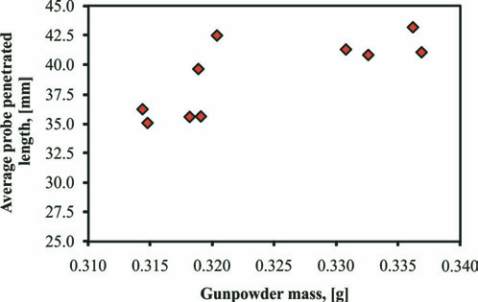Basic HTML Version



366
IBRACON Structures and Materials Journal • 2012 • vol. 5 • nº 3
Probe penetration test applied for evaluating shotcrete compressive strength
not worry about measuring the exact distance of the probe in the
trigger pipe every time the test is performed.
A total of ten tests were performed on the same concrete plate at an
age of 28 days. In each test, the powder contained in the cartridge
used in the test was measured, and the coefficient of variation was
determined. To reduce possible errors caused by the operator, all
tests were performed by the same, properly qualified individual. The
results obtained are discussed in the following section.
3.1.1 Results and discussion of results
The results of the embedded probe length and the cartridge pow-
der are shown in Figure 5. These values were calculated as the
difference between the average lengths of the pin, which, in this
case, was 54.9 mm, and average measured exposed length, as
depicted in Figure 3. Table 2 lists the values of the average em-
bedded probe length and the average powder obtained based on
the individual values highlighted in Figure 5.
Based on the results in Table 2, a total coefficient of variation
of 8.1% was obtained. The low coefficient of variation is connect-
ed, among other factors, to the small variation in the powder load
contained in the cartridge. Furthermore, the fact that the tests have
been carried out by the same operator and that the mixture of the
shotcrete has been produced with a coarse aggregate with a maxi-
mum dimension of 9.5 mm has also contributed to reducing the
total variability of the test, [1,2]. Due to practical measures that are
connected to the high number of tests to be performed and based
on the low variability of gunpowder, it was decided not to measure
the powder mass over the remaining experimental stages.
The determination the total number of tests n to be performed for
each concrete plate evaluated in stage 2 is based on the relative
maximum error E described in equation (1).
(1)
,
2
2
2
)1 (,2/
E
CV
t n
n
×
=
- a
where CV is the coefficient of variation of the test in percent, E
is the maximum relative error in percent, n is the total number of
tests, and t
a
/2
corresponds to the constant distribution of the t-Stu-
dent [18] test for a significance value of α/2. It should be noted that
the value of α was defined as 5.0%. Furthermore, it is highlighted
that the solution of equation (1) is obtained by an iterative process
because the constant value t
a
/2
is a function of n.
The lower the maximum relative error admitted, the greater the
number of tests that need to be performed. However, factors such
as the cost of conducting the tests, the amount of time working
inside the tunnel, and the equipment costs must be taken into ac-
count to minimise the amount of testing that is performed and,
consequently, the direct and indirect costs related to the execu-
tion. Depending on these variables and in accordance with the
technical team responsible for implementing the tunnel, a maxi-
mum relative error of 10.0% was chosen.
By applying the values of the coefficient of variation of the probe
penetration test, CV = 8.1%, outlined in Table 1 and the maximum
relative error, E
r
= 10.0%, fromequation (1), it was possible to obtain
Figure 4 – Propulsion energy (shooting): (a) maximum power and (b) reduced power
A
B
Figure 5 – Individual results of the penetrated
length of pins and the mass of
the gunpowder in the cartridge

